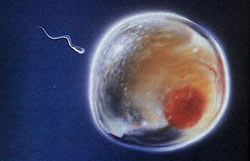|

All living things reproduce. Reproduction - the process by which
organisms make more organisms like themselves - is one of the things that sets living things apart from nonliving matter.
But even though the reproductive system is essential to keeping a species alive, unlike other body systems, it's not essential
to keeping an individual alive.
In the human reproductive process, 2 kinds of sex cells, or gametes, are involved. The male gamete,
or sperm, and the female gamete, the egg or ovum,
meet in the female's reproductive system to create a new individual. Both the male and female reproductive systems are essential
for reproduction. The female needs a male to fertilize her egg, even though it is she who carries offspring through pregnancy
and childbirth.
Humans, like other organisms, pass certain characteristics of themselves to the next generation
through their genes, the special carriers of human traits. The genes that parents pass along to
their children are what make children similar to others in their family, but they are also what make each child unique. These
genes come from the male's sperm and the female's egg, which are produced by the male and female reproductive systems.
Pregnancy
last approx. 38-40 weeks. The first 12 weeks are the first trimester. The second
trimester takes up 15 weeks. The third trimester has 13 weeks.
Without question,
the first trimester is the most important.
The
basic process for getting pregnant goes in this order. The female needs to be
ovulating. Ovulation is the 14th day of the female cycle when an egg is released. The male sperm needs to penetrate the egg/ovum.
After conception occurs the egg now embeds itself into the uterus wall, where it will develop over the next 40 weeks.

The above photo shows the male sperm on it's way to the female egg
Click on "More Photo's" to see more photo's of the developmental process
More Photo's
Sex determination

Humans usually have 46 chromosomes per diploid cell consisting of 22 sets of autosomes
and a set of sex chromosomes - either XX or XY. In the usual course of events, individuals with the karyotype
46, XX are female and individuals with 46, XY, are male. It is clear that the presence of
a Y chromosome is necessary for male sexual characteristics to develop. The number of X chromosomes present
does not play a significant role in sex determination. Below is a photo of these cells.

How twins are
formed:
Identical
twins are caused by one egg being fertilized by one sperm.
Sometime after fertilization, the egg splits into two genetically identical halves. Identical twins are always of the same
sex (although there has been very rare, as in only about 4 cases, of opposite sex identical because of genetic abnormality).
They share 100% of their genes, and are in reality, natural clones.
Fraternal
twins are formed when two eggs are released by the mother,
and each egg is fertilized by a different sperm. Fraternal twins can be of the same or opposite sex. They share up to 50%
of their genes, and are no more alike or different than any two siblings would be. It is also possible for fraternals to be
of different races or parentage, or to be conceived at different times, resulting in a large weight difference at birth.
Scary fact: Number of Teen Pregnancies, Girls 15-19, 2006 in Rhode Island - 2,430 (US-821,810).
By the time a child reaches 18 years of age, it will cost the parents $160,000 for the up bringing of their child. About one
in three teenagers becomes pregnant before age 20. Also,
- Teen mothers are less likely to complete high school, (only one-third receive a high school diploma) and more likely to
end up on welfare (nearly 80 percent of unmarried teen mothers end up on welfare).
- The children of teenage mothers have lower birth weights, are more likely to perform poorly in school, and are at greater
risk of abuse and neglect.
- The sons of teen mothers are 13 percent more likely to end up in prison while teen daughters are 22 percent more likely
to become teen mothers themselves.
Reasons teens give for having sex
- Peer/social pressure
- It feels good
- Pressure from partner
- No longer a virgin, so what's it matter?
- Lack of understanding about real love
- Rebellion
- Curiosity
- An expression of love & a response to the need to be loved
RI Stats #1
RI Stat #2

|

